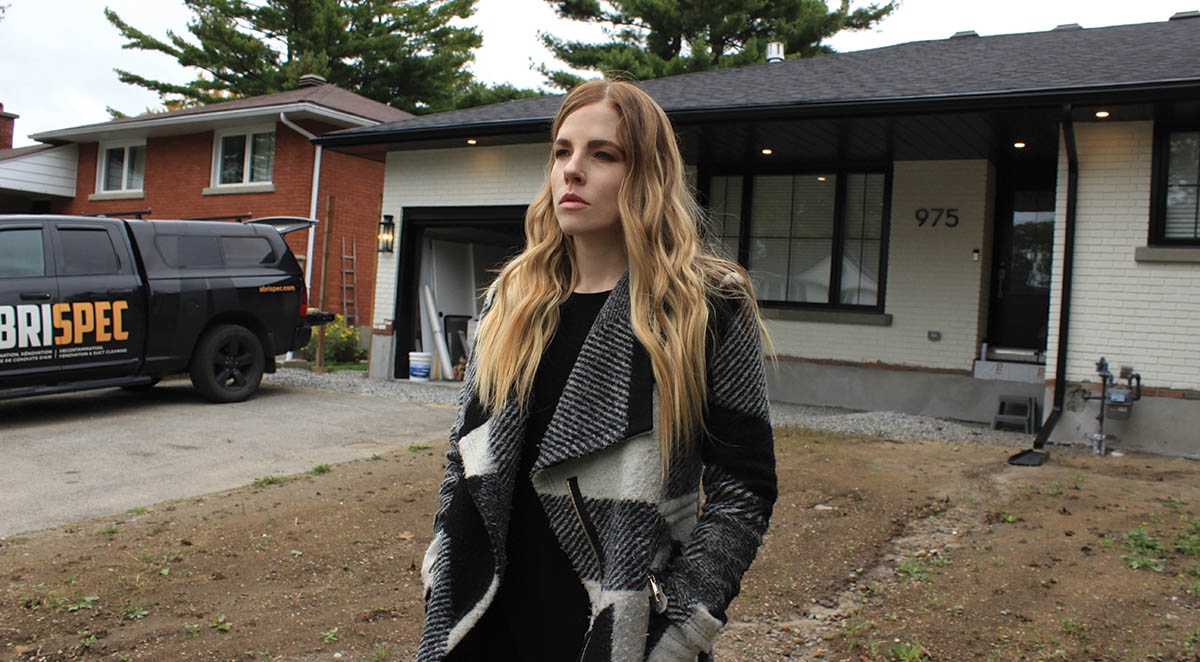
A Nightmare on Hare Avenue: How the right house could go so wrong!
ABOVE: Diane Clayton and her husband are going through a living hell after purchasing an “Elegant and Sophisticated, Fully Renovated,” home.
PUBLISHER’S NOTE: OLM contacted the Spaull Brothers of Digi Brokerage, Digi Brokerage CEO Jeffrey Mziray, and REMAX agent Julie Whittaker to respond to every issue raised in this article, but the request was turned down by all parties.
It read like a dream come true. “Elegant and Sophisticated, Fully Renovated 4 Bed/3 Bath Bungalow on Oversized Lot (64×129), Located in Prestigious Glabar Park. This Professionally Designed home boasts a stunning chef’s kitchen w/ custom cabinetry, New Jenn Air appliances, and quartz countertops w/ marbled backsplash”….and on and on. Diane Clayton and her husband must have felt like the luckiest homebuyers in town, that was until all housing hell broke loose.
The couple owned a recently-built, stylish semi-detached in Westboro. In 2021, they decided to look in the vicinity of that neighbourhood for a home that would make for a pleasant, long-term home that could also accommodate Larouche meeting clients at home. A den off the foyer, a nanny suite with a separate entrance, or even a large lot with space for a coach house would do the trick. There was nothing extravagant about their requirements, so the anticipation was that, even in a seller’s market, there would be abundant inventory to fulfill their needs.
No doubt you’ve seen those reassuring ads touting the advantages of engaging a qualified, professional realtor versus one of those sell-it-yourself online services that undercut the commission fee. The benefits, expertise, and commitment of realtors in this province are outlined by the Ontario Real Estate Association, whose first general obligation outlined in its Duties to Clients and Customers states that its members must: “1. Exercise care and skill: have the requisite knowledge and skills; provide complete and accurate information; recommend relevant experts, where applicable.” And so, based on a referral from another agent on the Quebec side, the couple engaged the services of Julie Whittaker of REMAX.
Pricing anything in a free market is a gamble, especially something with as many variables and as much personal meaning as a house. There are professional home stagers who know that a Pepé Le Pew cookie jar and the aroma of coffee brewing all add to the ambiance of what might become home. Air conditioning adds value during an open house in July, but in February, it’s just a technicality. Some people may love the idea of a wood stove, while others may find it a dusty pain that pumps carbon into the atmosphere. Savvy realtors may list a house below market value to stir up a bidding war fuelled by adversarial instinct and the gratification of victory. It’s all very intuitive, but buyers and sellers place their trust in their realtor’s rational expertise to calculate value based on comparable properties and other factors.

“This page (ABOVE) was removed when the Spaulls
were repeatedly contacted for comment on this article.”
At her introductory meeting with Diane and Pierre on October 4, Whittaker allegedly recommended a list price for their Westboro home (four bedroom, three-and-a-half bath, custom build) of $1,595,000. This number came as a shock to the couple after another realtor gave them a valuation of $1,160,000 only six months earlier. They had purchased the property for $870,000 in 2015. Whittaker had supposedly used standard practices to determine that hers was the price to go for based on comparable neighbourhood listings. Diane and Pierre have since pulled those comparables themselves, and of the four Westboro semi-detached homes they found to be sold in the ten months prior, the top sale price was only $1,389,000 for a unit much larger and newer than theirs. In those early days though, they still trusted Whittaker’s expertise and so calculated their maximum new home budget based on keeping their current mortgage the same and at least $100,000 in net gains to renovate or build a coach house in order to accommodate Pierre’s home office: $1,595,000 – 5% commission – $3,000 legal fees – $2,000 movers – $100,000 profit = $1,410,250.
A week later, the couple spotted on Realtor.ca the “Elegant and Sophisticated, Fully Renovated 4/Bed 3 Bath Bungalow” located on Hare Avenue in the Glabar Park neighbourhood. The details were spot on with their must-have list, as was the current asking price of $1,374,900 that even left them with some pocket change after the land transfer tax. With winter approaching and the thought of losing out on this perfect-for-them home, Whittaker allegedly recommended listing their Westboro property as quickly as possible with only five days of showings at a price point intended to incite a bidding war: $999,000. Once again, this number came as a shock to the couple. They repeatedly asked whether she’d ever seen a bidding war go more than half a million over the list price and received no clear reply, only urgings to proceed.
On October 22, Whittaker allegedly presented multiple purchase offers, with the highest being $1,325,000, well below the expectation and bottom line. Furthermore, several lower offers came in near or below the asking price of $1,160,000 recommended six months earlier. “At that point, we couldn’t figure out why Julie was presenting such low offers that came nowhere near what she knew we needed. It was like an anvil had landed on my head,” Diane recalled. “I knew that we were not getting that new house, and we felt it was just time to pull ours off the market because the reality was just so far off.” So much for bungalow sophistication.
With Hare Avenue now out of reach and the Westboro buyer unwilling to increase the offer, Clayton and Larouche instructed Whittaker to remove their home from the market. The next day, October 23, the buyer’s realtor contacted Whittaker with an offer increased to $1,400,000 with the condition that it come furnished at a value of $18,500. That left $1,381,500 for the property itself, furniture that needed to be replaced, and a final sale price more than $200,000 short of Whittaker’s alleged expectation.
On October 28, Whittaker reduced both parts of her commission (representing the couple as both sellers and buyers). The couple allege that, while Whittaker did not specifically discourage a home inspection, she did allegedly strongly recommend making an offer on Hare Avenue with no pre-conditions to secure the purchase from owner Christopher Spaull and listing realtor and brother Michael Spaull, who had no other offers in hand. Following negotiations, Spaull accepted the couple’s offer of $1,293,000 with a quick closing date of November 30.
An appraisal of the Hare Avenue bungalow was automatically ordered by the Bank of Montreal, the couple’s mortgage holder, which was conducted on November 16. On November 23, the BMO appraisal came back at $1,050,000, amounting to a $243,000 shortfall. Sure, mortgage appraisals are conservative, but this was a doozy of a difference. That’s when the red flags started to flap.
When peculiarities started popping up over the winter, the couple called in several contractors and inspectors to investigate. For starters, they were repeatedly informed that the two basement “bedrooms” could not be counted as bedrooms in the listing because neither had a legally-acceptable egress window (meaning, large enough to serve as an exit without physical support) nor a door directly to the exterior anywhere in the basement. They could only be described in the listing as finished basement rooms and not as bedrooms. A (legal) four-bedroom house lists higher than a (legal) two-bedroom house with finished basement rooms. It may sound like splitting hairs, but there is a measurable difference in market value. A realtor who spots an error can anonymously report it on the MLS site, with the listing agent receiving notice and 24 hours to correct the error or provide supporting documents to prove the listing information is accurate. The new information provoked what Diane called “an aha! moment” regarding what they paid for Hare Avenue relative to the bank evaluation. (Both the Spaulls and Whittaker were invited to explain how this could be listed as a 4-bedroom house but chose not to comment.)

“Maybe Stephen Hawking could’ve explained how
a house constructed in 1970 could appear in a 1958 aerial photograph!”
Another discrepancy was the construction year, stated as being 1970 in the marketing and “1970 approx” on MLS. Building Permit #26917, easily obtained by Clayton from the City of Ottawa, contains the original drawings and plans for the home, with the “Expected Date of Completion” listed as August 18, 1957. Given the benefit of the doubt, the Spaulls may have also obtained this permit to satisfy their professional obligation of prudence and estimated that the house took 13 years to complete (Windsor Castle took 16). Georges Masserey of Prime Building Inspection Services, hired by the couple in April 2022, recognized the house as being from the 1950s before he even walked through the front door. (The Spaulls were asked about this and replied through their lawyer with a no comment.)
Christopher and Michael Spaull are licensed realtors with Digi Brokerage of Ottawa and principals of Spaull Brothers Real Estate. Again, to avoid confusion, Christopher was the owner of the Hare Avenue bungalow until he sold it to the couple, and; Digi Brokerage and realtor brother Michael listed Hare Avenue on behalf of realtor brother Christopher. The relationship was disclosed in the MLS listing.
The “Ottawa Renovates” video series on the Spaull Brothers Real Estate Facebook page features Chris walking us through another property they’ve listed for sale. He tells us, “we bought this property with the intention of stripping it down…Follow along and watch us transform this house into an urban gem.” This could be what is known as house flipping, which is a legal, common, and highly-profitable practice among realtors. In another video celebrating the sale of Hare Avenue, Michael says, “Our team [meaning Spaull Brothers] was super proud to help our client [meaning brother Chris Spaull?] achieve the third-highest sale price for a bungalow in the neighbourhood.”
Anybody who has ever purchased a home knows that realtors indulge in expressive language that may innocently overstate things just enough to make the most humble hovel sound like Xanadu, but technical accounts must still be accurate. The property description in the advertising for Hare Avenue stated: Fully Renovated … NEW (2021) – ROOF; WINDOWS/DOORS; FURNACE; A/C; HWT; INSULATION; ELECTRICAL/PLUMBING. Turn-key luxury living awaits! The couple hired an array of specialist inspectors and contractors to investigate the “Fully Renovated … NEW (2021)” details one by one over the last eight months. This is what they learned.
ROOF/EAVESTROUGHS
Georges Masserey, an engineer and one of Ottawa’s most experienced inspectors, found the following:
• Installation of roof shingles is substandard. Crooked rows of shingles were noted, and excessive exposure of shingles was noted. This can not be corrected without completely replacing the roof > major repair. Please note that these deficiencies would most probably void any manufacturers’ warranties.
• Leaking eavestroughs were noted along the side of the garage in particular. The flashing or drip edge above the eavestrough does not allow water to flow properly into eavestroughs, and due to the protrusion of the fascia detail, it can actually allow water infiltration between this metal trim and rot out the original wooden fascia. (The Spaulls were asked about this and replied through their lawyer with a no comment.)
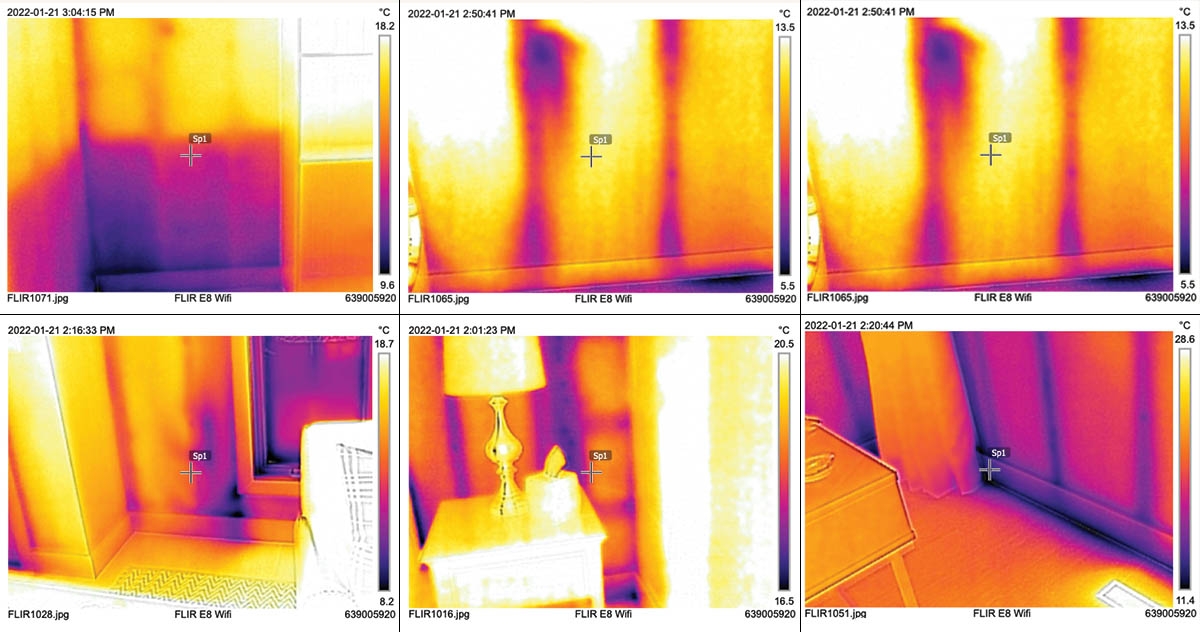
ABOVE: Shawn Rankin, Certified Level 1 Building Investigations Thermographer, scanned the walls and found serious issues.
WINDOWS/DOORS
It wasn’t long into winter that the couple discovered how drafty and uncomfortable their “fully renovated” house was, so they contacted Shawn Rankin, Certified Level 1 Building Investigations Thermographer at Indoor Air Quality Ottawa, to conduct an Infrared Thermal Imaging Scan. Rankin reported the following:
• Small basement sliders appear to be insufficiently caulked or the sliders misaligned as these windows suffer from pronounced air leakage contributing to indoor drafts and cooler rooms.
• The large patio slider in the dining room and the frosted casement in the master bedroom bathroom do not close and latch correctly. Gaps with air leakage and frost were noted at the window to frame unions. Please see Shawn Rankin’s images (above) of zero temperatures identified during the infrared camera scan.
The post-purchase replacement of the basement windows, intended to bring them up to proper “legal bedroom” standards, revealed missing areas of foam sealant, bug and mould infestations, and, for the larger window that the Spaulls installed, the old vapour barrier dangling loosely around it rather than being properly reattached. (The Spaulls were asked about this and replied through their lawyer with a no comment.)
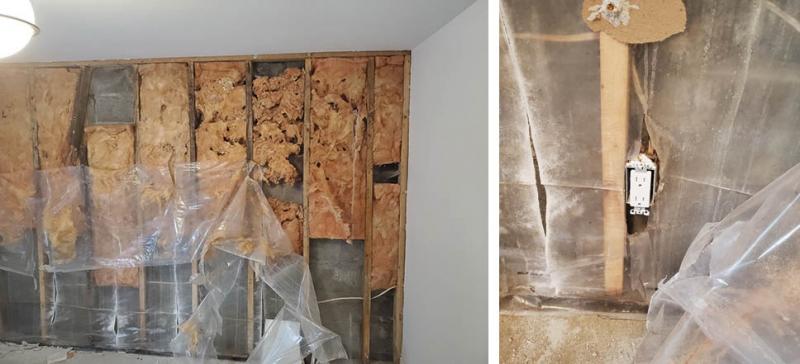
LEFT: Behind the drywall, the “new insulation” was anything but new.
INSULATION
“We moved in December 1, and with the first cold snap, we noticed a lot of cold air entering from around the windows. We had a surface thermometer we used during COVID, and it told us there was something seriously wrong in the walls,” Clayton says, and she was right. The thermal imaging scan revealed huge void areas in the walls. Cold air leaked in beneath baseboards along exterior walls on the main floor, and many cold spots that measured five or more degrees lower in surface temperature than other spots turned up in the scan of the same wall. A teardown of the basement drywall revealed what the “NEW (2021)” insulation looked like, and it’s enough to make you sick to your stomach. (The Spaulls were asked about this and replied through their lawyer with a no comment.)

ABOVE: Mycologist George P. White’s microscope images of multiple different hazardous moulds found at the fully renovated Hare Avenue home.
George P. White is a mycologist with over 33 years of experience, beginning at Agriculture and Agri-Food Canada. He did a thorough inspection of Hare Avenue. ”When I looked under the microscope at a sample of the pink insulation, it had some of the best-developed mould I have ever seen on fibreglass,” White reported. “It’s likely Cladosporium but could be something else. There was obviously a good leak there.” White found six different types of toxic mould, mites, and droppings from insects that eat mould, trim and carpet tack strips covered with fully-formed colonies, and rotted wood framing along the exterior walls indicating years of unaddressed water exposure. His report stated that it was impossible that the old drywall and carpeting removed during the renovation did not contain evidence of these multiple, well-established colonies of mould. Five gaping holes from prior venting outlets punctuated the walls with only a thin layer of mortar separating them from the outside, and which were found by the contractor to be soaking wet. (The Spaulls were asked about this and replied through their lawyer with a no comment.)
Both Clayton and Larouche have tested positive for multiple, highly toxic mycotoxins produced by the exact mould species found by White and are undergoing costly treatment for mould poisoning. If you want to know how the couple feels, move into a condemned motel and shove your head into the vacuum bag used to suck up the feculent carpets.
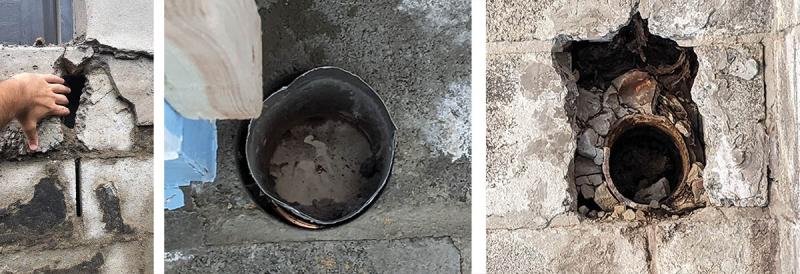
ABOVE: Among the source of the excessive whole-home humidity problems were a cracked foundation, structural gaps, and five gaping holes in the foundation walls from previous venting outlets.
ELECTRICAL
The couple noticed some electrical poltergeists haunting the house, including whole-house light dimming whenever the AC started up and bathroom ventilation fans that took several minutes to rev up to full speed. There were several clusters of live cut wires sandwiched into divider walls, plus old wires with worn-out sheathing stapled too far from service boxes. They are holding their wheezy breaths for what the main floor demolition—scheduled for next summer—might reveal. (The Spaulls were asked about this and replied through their lawyer with a no comment.)
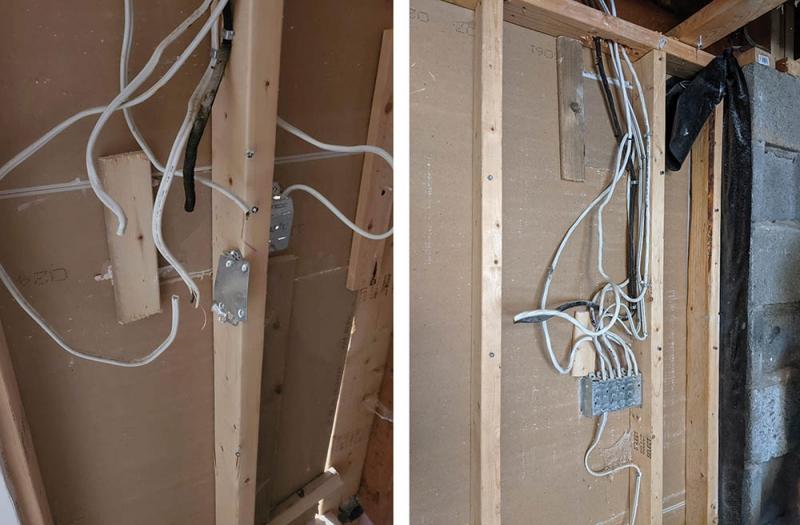
ABOVE: Drywall removal uncovered hazardous hidden wires that were definitely not to code.
PLUMBING
The new basement shower drain wasn’t connected properly to the sewer system and would have steadily leaked water into the slab with each use of the bathroom. There is still a four-foot length of corroded cast iron pipe going from the clean-out port in the basement closet to the city hookup outside the foundation. (The Spaulls were asked about this and replied through their lawyer with a no comment.)
AND ON AND ON…
Way back in November, the couple took a pre-closing walkthrough with Julie Whittaker. The couple noticed a mottled appearance on the carpet in both so-called basement bedrooms. It was allegedly explained as shoe marks from all the showings in which the realtors, apparently, allowed people to tramp around the house wearing dirty shoes, the strategy being that added filth always ups the selling price. They have since learned the cause is moisture wicking up from the concrete foundation floors upon which no subfloor or membrane had been installed.
During his inspection on February 2, 2022, Shawn Rankin of Indoor Air Quality Ottawa reported: “Excessive whole home humidity (noted by condensation on the new windows) has migrated into the attic, causing frost on the attic hatch assembly and on the underside of the attic roof sheathing. This condition will encourage mould activity in the attic. This type of humidity condition must have a source.” (The Spaulls were asked about this and replied through their lawyer with a no comment.)
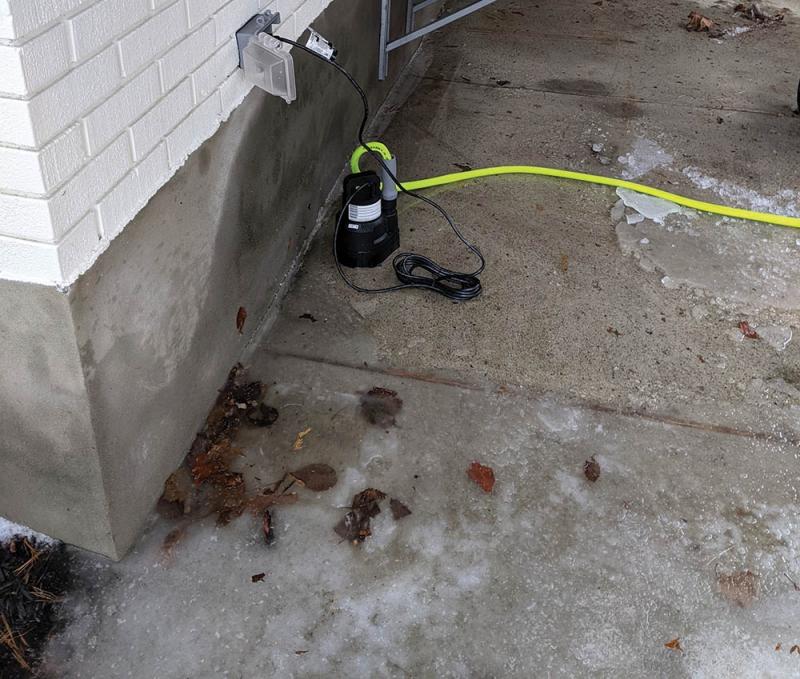
On February 17, 2022, during a thaw, Diane discovered water soaking into the carpet in Clayton and Larouche’s brand-new basement office. Sure enough, she located ice damming and standing water against the foundation, which she tried to mitigate with a pump, hose, and sandbags, along with dehumidifiers that have been running 24/7 ever since.
Between the droopy eavestroughs and the heaving patio stones, Shawn Rankin recommended Philippe Lafreniere of Abri Spec Inc. as the contractor he’d trust to do renovations on his own home and the guy to temporarily triage the problem of the water damming and prevent further water ingress during the spring rains and thaw until it could be thoroughly investigated. Things were about to go from living hell to downright apocalyptic.
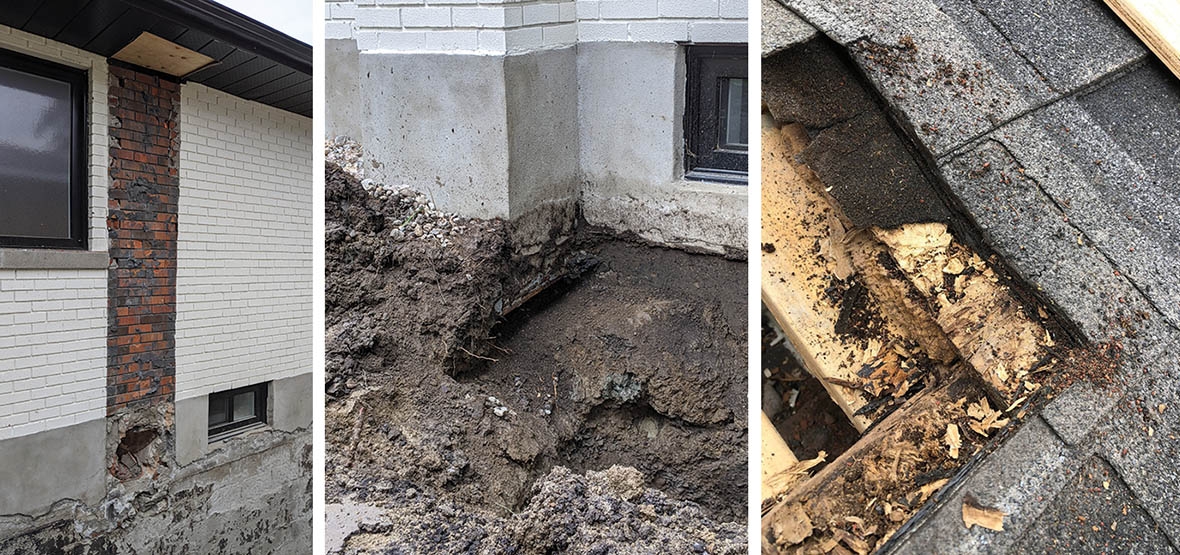
ABOVE: An old chimney was “unsupported” and had to be removed.
Abri Spec subcontracted the foundation team, Les Entreprises Lemont, to excavate and uncover the full extent of the deterioration, ruining the lawn and landscaping in the process. At present, the yard looks like tundra. The garage foundation was disintegrating, with large gaps, cracks, and missing infill support under the concrete slab. An unused brick chimney had no underlying support and was floating on the surface of the ground. In order to continue with the excavation and waterproofing, there was no choice but to remove it, meaning everything from the ground up to the roof needed to be repaired.
The demolition also uncovered improper decommissioning, severely deteriorated siding brick, roof rot, and a giant, wet, debris-and-mould-filled hole penetrating the foundation wall. (The Spaulls were asked about this and replied through their lawyer with a no comment.)
Georges Masserey reported major foundation and structural cracks that only became apparent after a winter freeze-thaw cycle when the garage heaved and broke through the freshly-installed drywall, parging, and freshly-filled and painted brick. A highly-skilled general house inspector may have questioned the fresh parging and raised a concern, but it was not until foundation specialist Patrick Lecours came on board to investigate these serious symptoms that the bandaged-up wounds were identified. (The Spaulls were asked about this and replied through their lawyer with a no comment.)
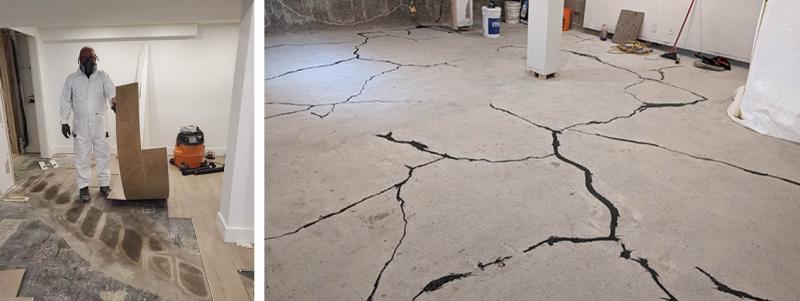
ABOVE: “The cork backing of every single plank throughout the entire basement was damp and covered with mould and efflorescence.” RIGHT: Cracks in the concrete basement floor.
Finally, all-new Luxury Vinyl Plank flooring was installed directly onto the still-damp concrete slab, ignoring the manufacturer’s installation instructions which require a poly moisture barrier. The cork backing of every single plank throughout the entire basement was damp and covered with mould and efflorescence, and was a complete waste. (The Spaulls were asked about this and replied through their lawyer with a no comment.)
According to the Canadian Real Estate Association (CREA) REALTOR® Code, a realtor is obligated to uphold the tenth standard of business practice which states:
The REALTOR® shall encourage parties to a transaction to seek the advice of outside professionals where such advice is beyond the expertise of the REALTOR®. 10.1. Outside professional advice would include, without limitation, lawyers, appraisers, home inspectors, surveyors, accountants, insurance agents or brokers, mortgage consultants, land use planners, and environmental consultants.
The three realtors did not, allegedly, “encourage parties to a transaction to seek the advice of…home inspectors,” although Mike Spaull highly recommends seller pre-inspections in a video in which he outlines the three costly mistakes that sellers should avoid. They are:
1. Overpricing. You’ll get more offers if you don’t. FYI: Spaull listed Hare Avenue at $1,399,000, then dropped it to $1,374,900 within a few weeks, then $1,349,900, then finally $1,324,900. The Spaull brothers had no other offer in hand for Hare when Whittaker allegedly advised the couple to pitch.
2. Skipping the staging. Which means picking up your socks and doing everything reasonable for a good first impression. Well, they ‘staged’ Hare Avenue alright, like the Metropolitan Opera stages Wagner. It was a “professionally designed” renovation similar to others they do around town, as seen in their “Ottawa Renovates” video series.
3. Avoiding a pre-inspection. To that last point, Spaull advises sellers to “give buyers the peace of mind that there’s nothing being hidden, that any deficiencies have been addressed. Transparency equals trust.”
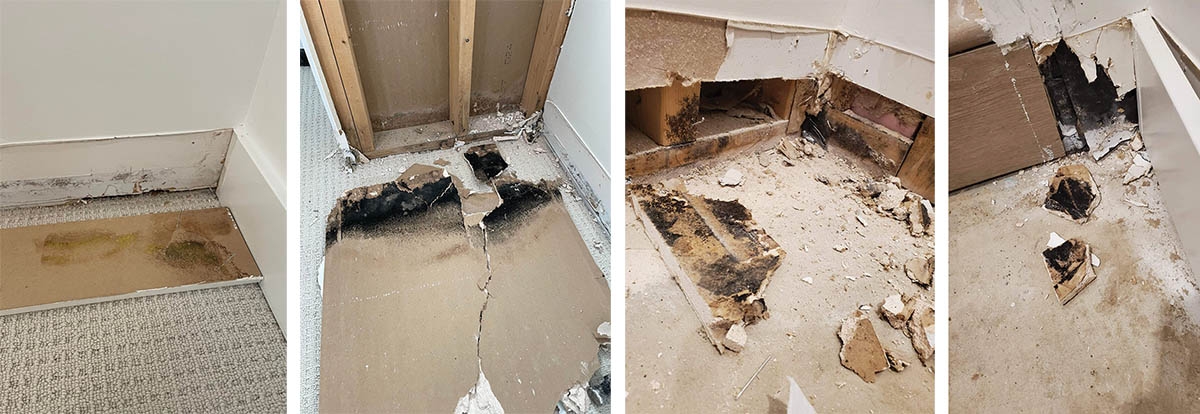
“His report (George P. White) stated that it was impossible
that the old drywall and carpeting removed during the renovation did not
contain evidence of these multiple,well-established colonies of mould.”
This last bit of sage wisdom raises a very interesting question. How did the Spaulls, in the course of working on this “fully renovated” house, during which they installed new drywall, flooring, parging, etc., etc., not discover infested pink insulation (see photos above), condensation (see photo above), a damp slab (see photos above), a crumbling foundation (see photo above), etc. etc.? If transparency is one of the Spaull hallmarks…well, I can hear my dear, late detective-sergeant dad say, “if it doesn’t make sense, then there’s probably something else going on!”
The Real Estate Council of Ontario (RECO) enforces the Real Estate and Business Brokers Act, 2002, “which promotes, among other things, transparency, honesty, integrity, and fairness in real estate transactions. Real estate professionals must provide competent and conscientious service.” Home buyers can contact RECO, whose complaints process ensures “fair and flexible handling of complaints about the conduct of real estate professionals and those holding themselves out as such [whatever that means].” RECO does occasionally issue what it calls “public advisories” regarding realtor/brokerage misconduct “to protect the public interest.” The last such advisory was issued 15 months ago.
So what happens when something as tangible as, for example, a wildly-approximate construction date is published in a listing? According to RECO, “All features of a property advertised by a brokerage must be technically accurate and not misleading. If there are concerns about fairness and accuracy in a listing, RECO will investigate valid complaints that fall within its authority under the Real Estate and Business Brokers Act, 2002. All advertising complaints must come from a Broker of Record or a consumer.” Home buyers rely on their representative realtor to know if a listing is technically accurate. Something as straightforward as the construction date can be acquired using Geowarehouse, a service available to all realtors to obtain the details and entire history of a property. Pop in $27.00 and you have a document with the construction date in a matter of seconds.
Until such time as a transaction is completed, RECO outcomes regarding complaints about misrepresentations in listings range from, “no action to ad corrections or removal, dispute resolution, warning and education, and discipline proceedings. It depends on the individual nature of the complaint, the impact, whether it led to damages etc. If it was done unknowingly, we would see if education was appropriate and follow a progressive discipline approach.”
Generally, once a transaction has been completed, disputes become a civil matter. RECO does not have the authority to, “address what a buyer or seller says or does,” nor does it, “award compensation or damages to complainants; that is, RECO cannot force the real estate professional to pay you money. We also cannot cancel a contract you have signed. Such concerns should be directed to the brokerage’s manager. These are matters you may wish to discuss with a lawyer.” And that’s exactly what Clayton and Larouche have done, resulting in massive claims being filed in Ontario Superior Court against Julie Whittaker and the Spaulls.
When all is argued and the costs tallied, we are left with an incalculable aspect to this tragic story, and that is the suffering endured by Clayton and Larouche. “My husband told me he woke up in a blind panic to the sound of me screaming in the middle of the night, only to find me sound asleep,” Clayton says. “So not only am I dreaming of water coming into the house in various ways every single night, but the nightmares are now assailing our already-grim days.”
She is a creator, he is a healer, and all they wanted was to shine as bright lights made brighter in the world by simply being at home together. What they got instead were days and nights made darker by an epic comedy of errors and an industry that lacks any serious regulations or enforcement powers concerning what is by far the biggest purchase, and the biggest gamble, any of us will ever make.









